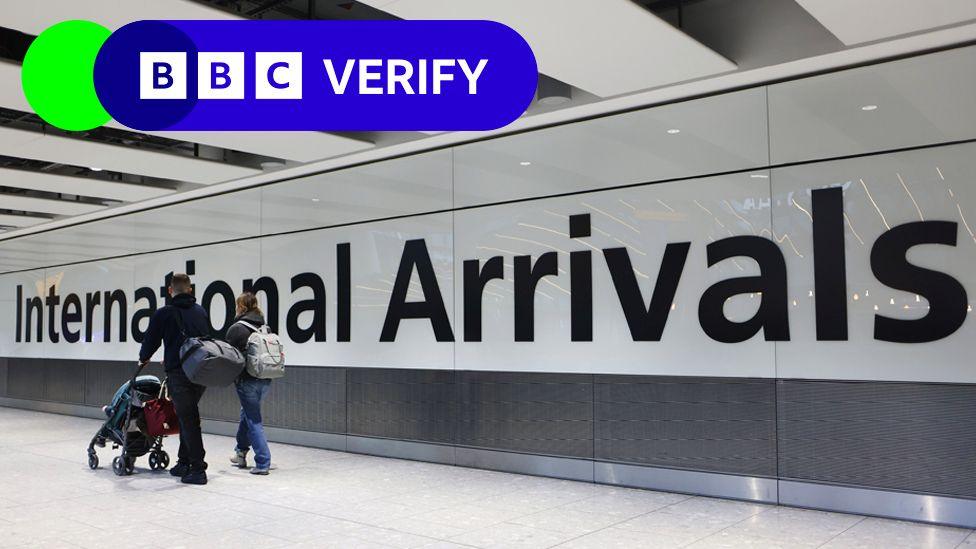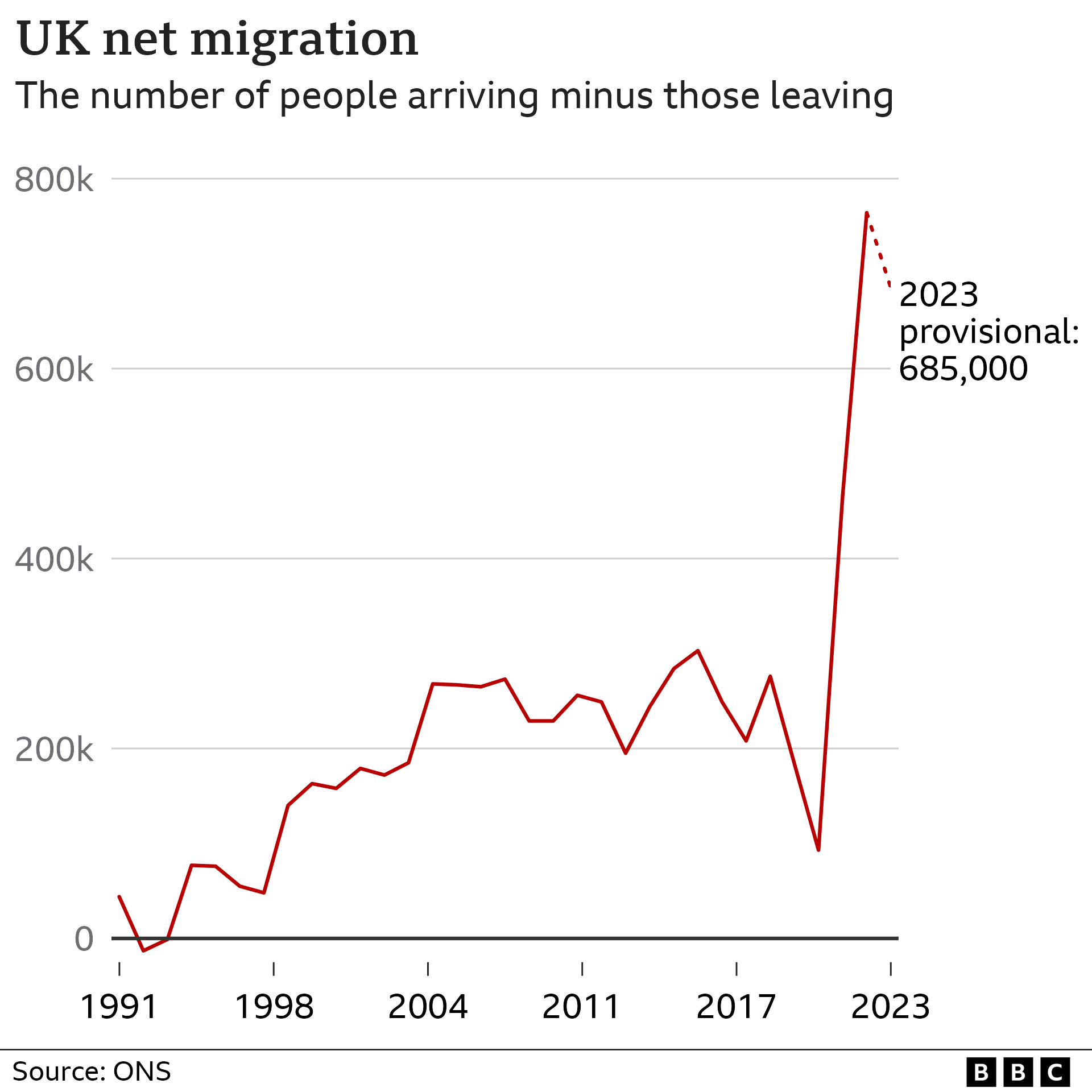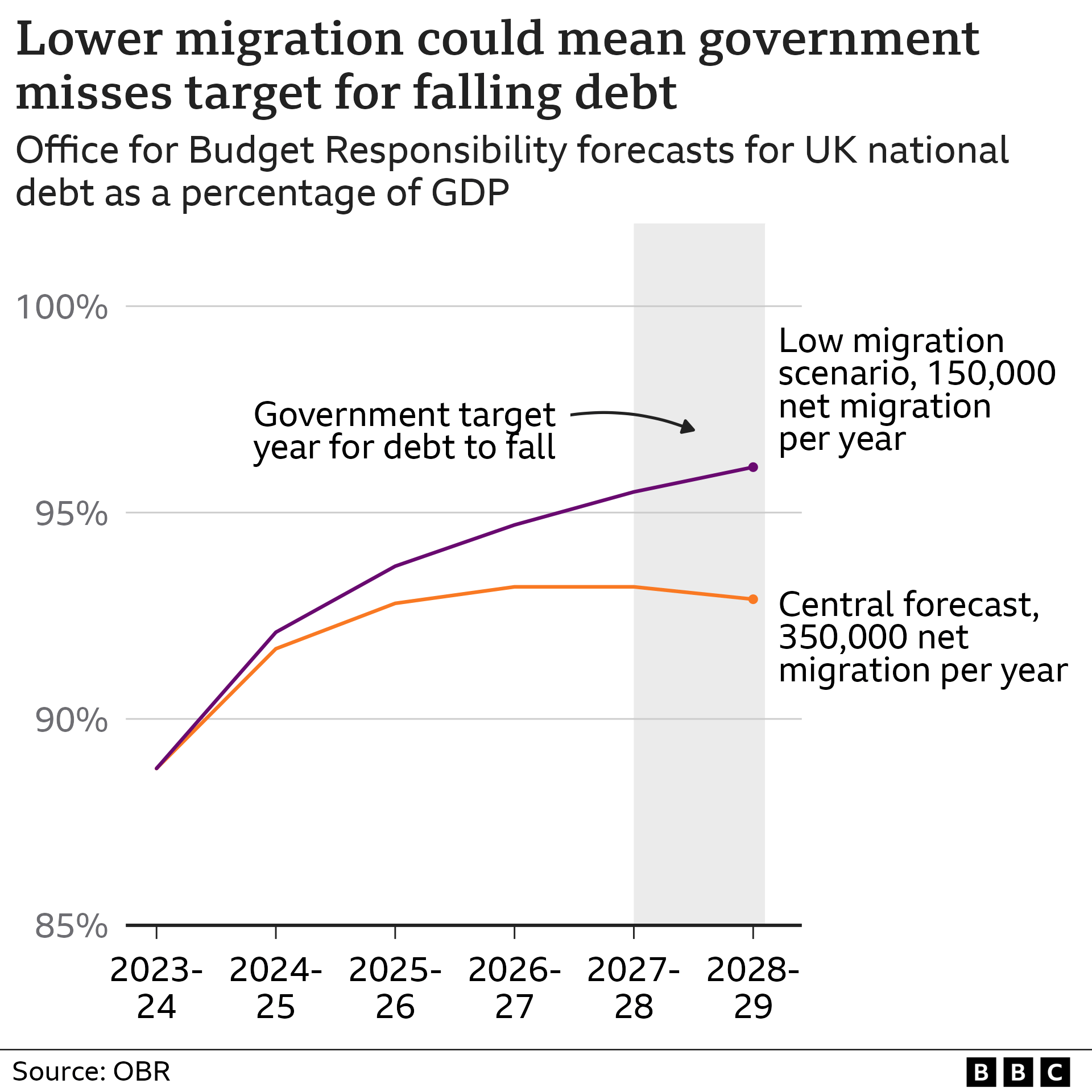What impact would the Tories' visa cap have?

The Conservatives are proposing a legal cap on the number of visas, but it could have an impact on tax revenues and public services
- Published
Net migration- the difference between the number of people coming to live in the UK and those leaving - fell by 10% in 2023, mostly due to fewer people coming on humanitarian routes from Hong Kong and Ukraine.
The Conservatives say falling migration means their measures to tackle it - including limiting visas for the dependants of care workers - are already working.
The Home Secretary James Cleverly told BBC Breakfast: "We have already started plans that have had an effect, and those figures have come down by 10%."
But the 10% drop refers to the change in net migration between 2022 and 2023, and the government’s visa reforms only came into effect in 2024 - although student and social care visas issued so far in 2024 have also fallen, external year on year.
The Tory party is also claiming its existing visa restrictions will mean 300,000 fewer people will be eligible to come to the UK in future - and that a new legal annual cap on visas will contribute to achieving a large reduction in net migration.
Is this accurate? And what would the impact of a new annual visa cap be?
Net migration already falling
The latest Office for National Statistics estimates suggest net migration in the year ending December 2023 was 685,000 - down from 764,000 in the year ending December 2022, which gives us the fall of about 10%.

However, the main driver was a decline in flows of people coming to settle in the UK from Hong Kong and Ukraine, external.
The claim that visa restrictions, including on dependants of social care workers, will reduce inflows by 300,000 is based on Home Office analysis, external of the migrants who came in 2023, external and would not have been eligible to come today.
But some of those people might come in other ways, such as on student visas.
A new annual visa cap could theoretically help to keep numbers down, although the Conservatives have not specified a number.
They said today that they would ask the independent Migration Advisory Committee to provide a recommendation for the level of the cap, which ministers would then consider and put to Parliament for a vote.
Wider implications of a visa cap
There are lots of people for whom a desire for lower migration is motivated not by financial and economic considerations but rather by a concern about its social effects - although the evidence is unclear about the impact, if any, of immigration on social cohesion, external.
Polling last year for the University of Oxford's Migration Observatory suggested a third of people thought immigration was a very bad or a bad thing, external, while half thought numbers should be reduced.
And there is some evidence that migration creates additional pressure on public services, such as demand for GP appointments, external.
A recent report by the Centre for Policy Studies noted that the share of the population arriving in the past two decades has increased the UK population at a faster rate than the numbers of doctors' surgeries and secondary schools, and the growth of transport infrastructure.
However, at the same time, there is also evidence that migration also helps relieve pressure on public services, external.
There are shortages of doctors and nurses which have been filled by migrants, external in recent years.
Training additional British workers to replace flows of NHS workers from overseas would probably come at a cost to taxpayers.
And higher wages to attract Britons into social care would probably be reflected in care costs.
The government's official forecaster, the Office for Budget Responsibility (OBR), has also suggested that lower migration would increase the national debt.
It presented a scenario in its most recent report looking at what would happen to the national debt, external as a share of gross domestic product (GDP) - the size of the overall economy - if annual net migration fell from its baseline average forecast of 350,000 a year to 150,000 a year.
With migration of 350,000 a year, the OBR’s forecast showed a slight fall in debt as a share of GDP, meeting its target in the final year, 2028-29.
But the lower migration scenario suggests the government would not be on course to hit its rule of having debt falling as a share of GDP by that point.

The OBR’s calculations were based on evidence that migrants are more likely to be younger and in work than the average person, so would make a larger contribution to tax revenues.
In his March Budget, Chancellor Jeremy Hunt justified his cut in the main rate of employee National Insurance by 2p in the pound on the basis that he had sufficient “headroom” against his rule on debt to afford the giveaway.
Labour has committed to the same debt rule as the Conservatives.
These OBR scenarios imply a short-term trade-off between lower net migration and the possibility of tax cuts or spending increases.
In the longer term, the impact of migrants on the public finances is thought to be more neutral because younger working migrants, presuming they stay, will ultimately retire and receive state pensions and other benefits and reduce some of their positive impact on tax revenues.
And some people might feel, in any case, that the short-term economic impact is a price worth paying for what they see as the social cohesion benefits of lower net migration.